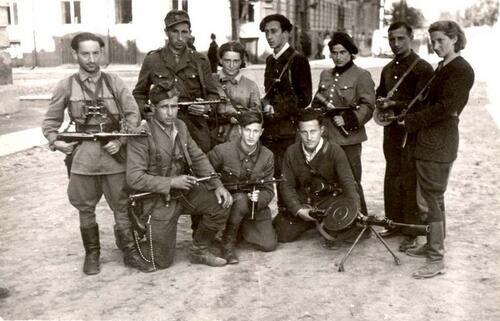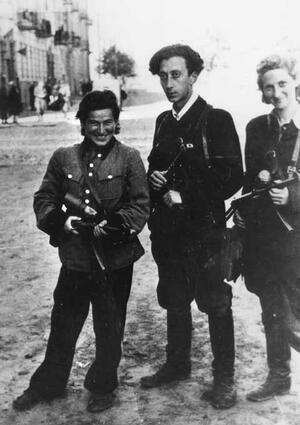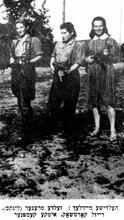Rozka Korczak-Marla
Women played an unusually prominent role in the Jewish underground in German-occupied Eastern Europe. Pictured here are three of the important leaders of the resistance in the Vilna Ghetto (L to R): Zelda Nisanilevich Treger, Rozka Korczak-Marla and Vitka Kempner-Kovner.
Institution: Yad Vashem, Jerusalem
Rozka Koczak-Marla was born in 1921 in Poland and joined the “movement” upon the outbreak of World War II. She was active in Ha-Shomer ha-Za’ir and took leadership in the United Partisan Organization, smuggling weapons into the Vilna Ghetto and helping Jews escape. She was among the last of the fighter to leave the ghetto in September 1943, carrying the movement’s archives on her back. After Vilna was liberated, Korczak immigrated to Palestine and integrated into kibbutz life. She ran Moreshet, an institute established to engage in research and publication of literature and Holocaust scholarship. She is remembered for her dedication to her family, work, and way of living.
“We did not have the privilege of choosing between converting to Christianity and sacrificing ourselves to sanctify the name of God—in this we differed from our ancestors. … We did have a choice of the manner in which to live to the very end as free Jews and die as liberated people.” Thus, in 1982, Korczak-Marla referred to the choice made by members of Synagogue cantorHalutz movements in the Vilna Ghetto.
Early Life and Education
Rozka Korczak was born in April 1921 in Bieslko, a small riverside village, near the Visla (Vistula), which had only forty Jewish families. Her father Gedaliah (d. 1940) was a cattle dealer, a tradition-respecting Jew, and an aspiring Zionist. Two younger sisters, Teibel (b. 1924) and Rachel (b. 1927) perished together with their mother Hinda in c.1942.
Since there was no Jewish school in her village, Korczak studied at a Polish school. In the eighth grade she organized a strike of Jewish pupils in protest against the principal’s anti-Semitic remarks. At the same time, she also studied the scriptures and the Lit. "teaching," "study," or "learning." A compilation of the commentary and discussions of the amora'im on the Mishnah. When not specified, "Talmud" refers to the Babylonian Talmud.Talmud in a Lit. "room." Old-style Jewish elementary school.heder, seated at a side table, not around the central one, which was reserved for boys.
With the decline of their financial situation, the family moved to Plock (94 kilometers north of Lodz) in 1934. Despite her craving for learning, fourteen-year-old Rozka decided to work due to the shortage of money in the family. She acquired knowledge by attending evening classes and by reading books. “These were my universities,” she said. Having read Autoemancipation (1882) by Leon Pinsker (1821–1891), she found her way to Ha-Shomer ha-Za’ir, where she became an instructor and a member of the leadership. Her loyalty to the socialist movement soon led to conflict with the traditional way of life at home. Korczak, true to her promise, went out on a trip with her group on The Day of Atonement, which falls on the 10th day of the Hebrew month of Tishrei and is devoted to prayer and fasting.Yom Kippur, but she also observed the fast.
World War II Resistance
Upon the outbreak of World War II and the German invasion of Plock, Korczak-Marla witnessed acts of violence and humiliation against Jews. Soon thereafter, she informed her parents that she was leaving to join her comrades in the “movement.” In Warsaw, in November 1939, she met Tosia Altman (1918–1943), who informed her about the gathering of movement members in Vilna (Vilnius). There she learned of her father’s death and her family’s deportation to Piotrkow Trybunalski (45 km SSE of Lodz). She joined the commune and worked, together with Vitka Kempner and others, rinsing pig bristles for the brush manufacturing industry. Ha-Shomer ha-Za’ir went underground after the incorporation in July 1940 of Lithuania, and with it Vilna, into the Soviet Union. In addition to working, Rozka Korczak attended an evening high school to improve her knowledge of Yiddish and Jewish culture. On June 24, 1941, two days after invading the Soviet Union, the Germans occupied Vilna. Korczak and her comrades decided to escape to the East and join the Red Army, but the German army overtook them.
In July, the Germans and Lithuanian volunteers rounded up five thousand Jewish men, taking them to Ponary (12 kilometers from Vilna), where they were murdered. That was the first, but not the last mass murder in Ponary. The members of the movement tried to save themselves with forged documents. On September 6, 1941, two ghettos, for 28,000 Jews who escaped the killing, were established in Vilna. Ghetto No. 2 included the “superfluous” population, destined for extermination. As the horrible truth about the mass murders reached the remaining people in the ghetto, the movement members argued constantly about their ultimate commitment: should they stay with the community in Vilna or find their way to another “safe” ghetto? Rozka Korczak was among those gathered for the historical meeting on the eve of December 31, 1941, at which Abba Kovner (1918–1988) read aloud a manifesto which stated, in part: “Hitler plans to kill all the Jews of Europe. … Let us not go like sheep to the slaughter.” On January 21, 1942, a Jewish combat organization was established, the Fareynegte Partizaner Organizatsye (United Partisan Organization; FPO). Korczak, who documented this gathering in her book Flames in the Ashes, insisted both in 1945 and in 1988: “You may by no means say that whoever supported the uprising became a hero, and whoever objected to it was a coward. It was not divided like that.”
While serving as an active member in initiating the establishment of the FPO, she took care of orphans and also became a “mother” to her comrades. At the same time, she worked in the ghetto library.
On the night of July 15, 1943, when Jacob Gens (1905–1943), the head of the Judenrat, complying with German demand, was about to hand over the FPO’s commander, Itzik Wittenberg (1907–1943), Korczak and Vitka Kempner, together with others, rescued their commander by a brave operation. However, because of the severe confrontation between the FPO and the Jews in the ghetto, Wittenberg gave himself up to the Germans. In her book, Flames in the Ashes, Korczak describes the separateness of the underground members, the responsibility they felt for the Jewish community, and their resolution to leave for the forest. She herself was among the last group of fighters who, in September 1943, left the ghetto through the sewage canals for the forests of Rudninkai, carrying the movement’s archives and Abba Kovner’s poems on her back. In the forest, an autonomous Jewish partisan brigade had been organized under the command of Abba Kovner. In charge of managing the camp life of the Jewish unit, Korczak handled food acquisition and distribution, the organizing of laundry and equipment—complicated issues in a harsh reality of severe shortage and poverty. At the same time, like other women, she struggled for the right to participate in combat. “I recall that in the first operation I was chosen along with one of our female comrades; we felt that the entire fate of the female sex depended upon us. If we fulfilled the task we had been trusted with, we would pave the way for the other girls.”
On July 13, 1944, Vilna was liberated and Abba Kovner, Vitka Kempner, and Rozka Korczak returned to the city, together with several hundred survivors. There they discovered that the ghetto had been totally destroyed. In this situation they decided to organize the remaining Jews and the refugees for immigration to Palestine. Korczak left for Kovno to search for survivors, partisans, and movement members. In December 1944, Kovner sent Korczak and Dr. Shlomo Amarant (d. 1995) to find ways of passage to Romania and Black Sea ports. In Bucharest the messengers of He-Halutz bade her to leave for Palestine and reveal her story to the Jewish public. Her first home was in A voluntary collective community, mainly agricultural, in which there is no private wealth and which is responsible for all the needs of its members and their families.Kibbutz Eilon where, in 1945, she began her great book of testimony, Flames in the Ashes. In January 1945, she addressed the Executive of Ha-Shomer ha-Za’ir, unfolding to them the narrative of agony, extermination, and heroism during the Holocaust. A petite young woman with delicate features and a modest smile at the corners of her mouth, speaking Yiddish in a quiet, subdued tone, she was among the first who introduced the story of the Holocaust and heroism to the Palestine Jewish elite. Employing the terminology of pain and strength, she presented to the public an extensive and detailed account of Holocaust events, describing how the concept of armed resistance had been crystallized among the members of the Halutz movements, which functioned as the avant-garde and leadership of the Jewish people during the Holocaust.
Kibbutz
Together with Vitka Kempner, Abba Kovner, and Chesia Rosenberg (b. 1920), Korczak was accepted as a member of Kibbutz Ein ha-Horesh in October, 1947. There she married Avi Marla (b. 1922). The couple had three children: Yehudah (b. 1952), Yonat (b. 1954) and Gadi (b. 1959).
Rozka Korczak-Marla integrated into kibbutz life as an educator and public figure. She served two terms as kibbutz secretary, from 1958 to 1961 and from 1980 to 1981. She perceived herself as an educator due to the determination and humane attitude she had derived from her personal experience of the Holocaust. In a debate held in 1974, she said: “Our failure will be if we lack the will to respond to them [the youngsters] honestly, in a clear manner. We—including the Jewish people in its own homeland—should all learn and teach how to live with the hazardous reality called Judaism—all this out of love and with critical awareness. Nevertheless, we should live with the problematic aspects, for we have no other life.”
Korczak-Marla was a dedicated and loyal member of the kibbutz. Yet the leadership considered her, like all Holocaust survivors, as being in need of “re-education.” In 1947, she complied with a verdict to postpone her studies, in spite of her strong desire to learn. She accepted the verdict that studying “was not to be recommended” and consented, “with quite hard feelings, but fully aware of the necessity to do so.” Since, unlike Kovner, she was not perceived as threatening by her movement’s leaders, she was recruited in 1947 to work among the new immigrant partisans in order to help them adjust to reality in Palestine.
Later Life and Legacy
In the sixties, as a partner and, later, the head of Moreshet, an institute established by Ha-Kibbutz ha-Arzi to engage in research, collection of testimonies, and publication of literature and Holocaust research, she was fully involved in every book, pamphlet, and event. With her subtle criticism, sense of humor and sensitivity, she played a central role as editor and as an authoritative figure in various aspects of editing and publication. In a speech delivered in 1984, on the twentieth anniversary of the publication of the first Moreshet pamphlet, she underscored the significance of publishing testimonies and journals from the Holocaust together with engaging in research. These testimonies should represent “the humane, ethical, national and spiritual perspective of Jewish existence during the Holocaust,” she said. Her attempts and those of others to erect the Moreshet building were unsuccessful. In the last year of her life, she complained bitterly about this failure: “Commemoration is the task of the movement, not mine. I have done my bit. For years nobody in the Kibbutz ha-Arzi has cared. This movement and its present leadership are unworthy of the movement they had abroad.”
Korczak-Marla had an outstanding ability to listen to people and to display empathy with those who approached her, on the kibbutz and outside it, as well as in Moreshet. She lent an ear to people in distress and they consulted her on various issues even when she was in public office. She continued her activity in Moreshet until her last days, reading, writing, and counseling, emanating love and support for writers, humbly negating herself. On the other hand, she was eager to discuss her family, children, and grandchildren. Throughout the years, a deepening friendship developed between the Korczak-Marla family and the Kovners, so much so that they constituted a unique social unit.
Rozka Korczak-Marla died of cancer on March 5, 1988. Her children wrote after her death: “Mother lived a life of dedication and that way of life became virtually a character trait.”
Barzel, Neima. A Sacrifice Unredeemed: The Encounter between the Leaders of the Ghetto Fighters and Israeli Society (Hebrew). Jerusalem: Mosad Bialik, 1998.
Interview with Shmuel Huppert (January 1988) in Rozka Korczak-Marla: The Personality and Philosophy of Life of a Fighter (Hebrew). edited by Yehuda Tubin, Dror Levi, Yosef Rab. Tel-Aviv: 1988, 29.
Interview with Carmela Lachish (December 1987) in Rozka Korczak-Marla: The Personality and Philosophy of Life of a Fighter (Hebrew). edited by Yehuda Tubin, Dror Levi, Yosef Rab. Tel-Aviv: 1988, 9.
Korczak, Rozka. Flames in the Ashes (Hebrew). Merhavyah: ha-Kibbutz ha-artsi ha-Shomer ha-tsa’ir, 1956.
Gefen, M., Haika Grosman, Shalom Holavski, Segal, Y., Abba Kovner, Rozka Korczak, eds. The Jewish Partisan (Hebrew). Merhavya: ha-Kibbutz ha-artsi ha-Shomer ha-tsa’ir 1958.
Korczak, Rozka and Yehuda Tubin, Yosef Rab, eds. Zelda the Partisan (Hebrew). Tel Aviv: 1989.
Korczak, Rozka and Yehuda Tubin, eds. Aba Kovner: Seventy Years (Hebrew). Tel Aviv: 1988.
Korczak, Rozka. “The Struggle for a Fighting Jewish Brigade.” In The Jewish Partisan. edited by M. Gefen, Haika Grosman, Shalom Holavski, Y. Segal, Abba Kovner, Rozka Korczak, 259–310. Merhavya: ha-Kibbutz ha-artsi ha-Shomer ha-tsa’ir 1958.
Korczak, Rozka. “The children struggle in Buchenwald Concentration Camp.” Yalkut Moreshet 8 (March 1968): 41–74.
Korczak Rozka. “Information and Knowledge.” Yalkut Moreshet 33 (June 1982): 59–63.
Korczak, Rozka. “David Novodborsky: Image of a Fighter.” Yalkut Moreshet 35 (April 1983): 79–100.
Korczak, Rozka. “Mira Melamed: Image of a Fighter.” Yalkut Moreshet 42 (December 1986): 155–172.






